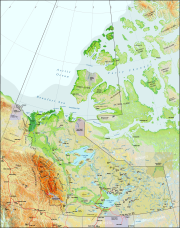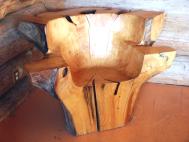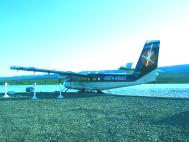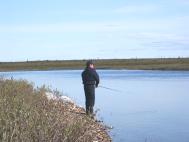
cropped image
full image
Norman Wells was the end of the first phase of our journey. Until it was time to head home, I was no longer pilot. Norman Wells is a town of 800 residents, on the MacKenzie River, 90 miles south of the arctic circle. There is no year-round road to Norman Wells, though they plow an ice road that's open for about six weeks each winter.
Here's a closer view of the Northwest Territories. It shows the Horton River more clearly than the earlier map and it also shows the towns of Norman Wells and Inuvik which come into the story.


We'd made it in time and in fact were a day before anyone else. We hooked up with the people at North-Wright Airways who were going to be our charter service to the Horton River and they put us up at their cabin at the seaplane base. We'd heard about this cabin and I'm afraid we pictured something a bit on the crude side. Convenient yes, but perhaps not the nicest of places to stay. Wow, what a pleasant surprise the cabin was.



Floating out front was the Twin Otter that would carry us and our canoes out to the Horton and a Pilatus PC-6 Turbo Porter.
Over the next couple days, Andy, Eric, Marilyn, and Robert arrived in Norman Wells and we finished our final preparations for the trip. We also got to meet everyone. Robin and I knew each other before this expedition but no one else did. Robin, Andy, Eric, and I had all gotten together to buy and pack food about a month before and Marilyn and Robert had met each other and even canoed together; now we all got to meet each other.



Here's upstairs in the cabin where we had all our stuff spread out as we packed and repacked it.

On June 28th, just as scheduled, we loaded up the Twin Otter and headed off to the Horton Lake to begin our trip. The Twin Otter was capable of carrying three canoes, all our gear, and all six of us in one load. And the canoes all fit inside. Since it was a two hour flight out there, multiple trips would have been painful.



One of our concerns had to do with our start date. We had to schedule the trip far in advance and we wanted to start as close after ice out as possible, but not before. June 28 was a guess, sometimes ice was out by then, sometimes not. On the flight out we saw more and more ice and got more and more nervous. Two hours out just to turn around and fly back, would have made for a bad day.

Finally, over Horton Lake, this was the view out the pilot's window.


Fortunately, right at the outlet of the lake where we wanted to put in anyway, the lake was open so we were able to land and unload.

After unloading, the pilot pulled out his fishing rod, walked out to the end of the floats, and started casting. After a few minutes there with no results, he walked down the shore a ways and tried some more. Within five minutes he'd pulled in a lake trout that was at least 30 inches long. He threw it in a cooler full of ice he'd brought along saying the boss asked for a fish for dinner.
I looked at the size of the fish and thought about the lures I'd brought along. Then I looked at the size lure the pilot had used. Oh dear; did I ever guess that wrong. Asking around the rest of us, we'd all gotten it wrong. The pilot gave us a few larger, barbless lures.


So we loaded up the canoes and started down the river. The first eleven days of the trip were sunny and warm. Temperatures in the 60's and 70's, not too chilly at night, in fact we went looking for exposed campsites so we could get as much relief from the mosquitos and black flies as possible.

The insects weren't really as bad as some of the horror stories we'd read but there were good times and bad. Here you can see a picture of the well dressed arctic traveler. Note the bug shirt, the hands in the pockets, and (if you could see it) my pants tucked into my boots. As little exposed skin as possible is the rule.

I wanted to get a picture of someone totally covered with mosquitoes, the standard picture of how bad it can be, but this is the best I came up with. Not that this is the worst the bugs ever were, it's just the picture I got.
The bug shirt worked pretty well and I basically lived in it after the first few days. The first time I put it on was because of black flies. Once I got the hood zipped up, the black flies then bombarded my head and it sounded rather like rain on a tarp but they couldn't get to me and I was a happy camper. Literally.


Now life in the arctic wasn't all fun and games; it was serious business. What with avoiding mosquitoes and dodging grizzlies, dealing with blizzards and fierce winds, we were never able to let our guards down. Certainly we never fooled around while on the river.
In actual fact, the Horton is an easy river to canoe. Most of the river drifts along at a comfortable current with the occasional bit of faster water just to keep you awake. With the exception of the canyons, the entire river would be quite easily managed by anyone who can keep from tipping a canoe over. At least as far as the canoing is concerned. It was important to always be mindful of our remoteness though. Despite the beautiful weather and easy canoing, the consequences of mistakes had somewhat more import than canoing a comparably easy river in inhabited parts of the world.

The beginning of the trip, the Horton Lake, is just north of the Arctic Circle. As far north as we were, there were still trees around. You can see that in the background of many of the pictures. I'll come back to this as we move north.


A pretty typical campsite was just to drag the canoes up on a gravel bar and pitch the tents. The size of the gravel varied from sand to fist sized rocks and sometimes it took some effort to successfully tie the tents down.

We'd usually set up a canoe as a windbreak for the stoves. We brought along three MSR Whisperlite stoves and 6 (?) gallons of whitegas. We figured that having the same stoves would help in the case that repairs were needed and three of us had Whisperlites. We had fires a few times on the trip but the stoves were so much easier and quicker to get going and they don't make your pots all sooty. Later in the trip, when the weather turned colder, it would have been nice to have more fires but, by that time, there was little to no firewood to be found.
Continue with Canoing, Part 2.